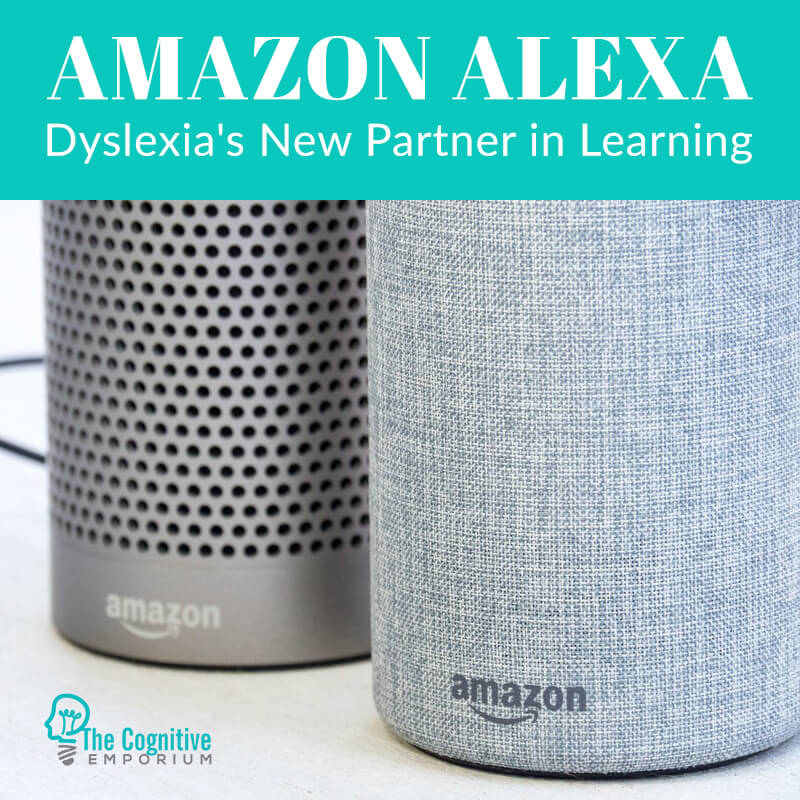10 Ways Amazon Alexa Can Help Students with Dyslexia

Students with dyslexia just gained a new friend and her name is Alexa.
When used correctly this brilliant piece of technology, can make learning faster and more efficient for the struggling learner.
A dilemma parents often face when their child struggles with reading, is how much assistance should they allow.
I’m a huge fan of all students developing grit by doing hard things, however, I am also a realist.
The reality is that in today’s world, the majority of students utilize technology to assist with school work. So, refusing to allow the struggling student, who more than likely thrives when technology is used, basically ties their hands.
When I meet with parents and ask them why they ban technology for learning I get usually the same two reasons: fear and control.
They fear creating a dependency and lack of learning and they feel they lack the ability to control what the child uses it for and create boundaries.
Recently, a dad, who ironically enough happened to be a computer engineer, came in with his son for a consultation.
He shared up front that he and his wife had strict rules about technology in the house such that, basically, it was not allowed.
During the consultation, he also shared that his own struggles in school were similar to his son’s. I asked him how he thought his school days would have been different if he had been raised with today’s technology.
Without skipping a beat, he replied, “My homework time would have been reduced, I would have been more engaged, and I may have actually learned something.”
I think he could tell by the look on my face where this conversation was headed.
I told him, “You came to me looking for a way to decrease your son’s struggle, get him motivated to learn, and complete his work.
“You also told me what would have helped you. I think we found a good place to start.”
Don’t get me wrong, technology was not the answer to why his son was struggling and his answer to my question most definitely wasn’t the plan I subsequently recommended to turn it around.
Technology, however, was necessary to engage his son.
It was the buy-in we needed; and for the older struggling student, buy-in is a crucial key to change and transformation.
Parents need to identify their overall goal and believe that their child has the same one.
For the student who struggles to read, it is to read.
The Amazon Alexa is a tool of acceleration that can reignite the motivation to learn, and often external motivation is how intrinsic motivation is born.
The second part to that is that all children in today’s world use technology. So to prohibit its use for a child to whom technology is socially necessary will actually be perceived as hurtful.
A balance is needed for sure and boundaries should be set in order for abuse not to happen, but, in the end, Alexa is a friend that I recommend every household invite over to their house to help the struggling learner.
Below is a list of just a few of the ways that Alexa brings her “A-game” to the learning house:
Note Taking
If your student struggles with handwriting, including dysgraphia, you can enable the My Notebook Note-Taking Skill in Alexa. This creates notes in your favorite services, such as Evernote and OneNote.
When enabled, your child can tell speak their brilliant thoughts or a to-do list Alexa stores and organizes it for them.
If your child can tell you a story but has difficulty putting pen to paper, your student can use this as a way to make writing easier.
Spelling
Alexa can help with spelling just by asking her, “Alexa, how do you spell ‘generation’?”
It’s not uncommon for written expression in students with Dyslexia to suffer because they fail to use words that they can’t spell.
If you don’t believe me, ask your child to tell you a story about something that they love or are passionate about. Their story will be full of age appropriate vocabulary and full of details.
Then ask them to write down the first part of the story. Notice what they leave out.
You want to encourage your child to reach out for assistance if they don’t know how to spell something.
Engaging Alexa to help will give the child practice in spelling the word and also increase their exposure to seeing the word in print.
Listening Comprehension
One of Alexa’s skills is Listening Comprehension Practice.
Enabling this skill offers students with Dyslexia who struggle with listening comprehension a great way to get them to practice.
Alexa will tell quick and fun stories and then ask questions about the story. Alexa will even verify if the response is correct.
Word Definitions
Alexa has a built-in dictionary and will look up the definition of any word.
But a word of caution: she does have difficulty with homonyms and homophone words that are pronounced the same but mean something different.
Sync Alexa with Google Calendar
can assist your student in learning the days of the week and the months of the year, something that children with Dyslexia struggle to learn. You can also create a google calendar for your child or link their google classroom account up and voila: there will no longer be any excuses for missed assignments.
I recommend training your child to ask Alexa every morning about today’s daily events. This is a great orientation and mental prep for the day.
Build Vocabulary Skillls
Word knowledge is something that struggling readers are weak in due to the delay in their reading ability. By enabling Daily Word in Alexa you can help your student build their vocabulary.
An easy way to make this fun is by playing a game. Every day at breakfast say, “Alexa, open Daily Word” then challenge your child to use that word throughout the day.
Then, that evening, challenge them to recall the word and use it correctly in a sentence.
You can even keep score or give rewards when your child correctly recalls the word and is able to use it correctly.
Reading Comprehension
Ask Alexa to read books from Kindle or Audible. Say, “Alexa, read me “A Wrinkle In Time.”
For students with Dyslexia, an enormous amount of reading after school can be overwhelming.
Parents should pick and choose, then prioritize what their child needs to read and what can be read to them.
The expression “The more a child reads, the more a child learns”, does not mean the more a child reads only using their eyes. The goal is to increase learning and Alexa can help with this.
Homework
Yes, the struggle is real.
Homework is a sticky point and a daily wrestle for most parents I meet with.
If your child is overwhelmed and has difficulty chunking their time to increase productivity, use Alexa to set up study breaks.
You can tell Alexa to “Set the timer for 10 minutes” then let your child know that when the timer goes off they can take a break.
Repeat the request for a timer and let your student know that when Alexa says that time is up, they need to resume their studies.
Learn Multiplication Facts
Some students with Dyslexia also struggle to learn multiplication facts.
Enable the Let’s Multiply skill then say, “Alexa, open ‘Let’s Multiply.’”
Alexa will run multiplication games with your student that will encourage repetition and learning.
Increase Verbal Memory
Alexa loves to play Simon Says. This is a fun game that the whole family can play. Just say, “Alexa, Simon Says: Ball, Bike, Hot dog, Baby”
Alexa will repeat the words given. Then turn to your child and say, “What did Simon and Alexa Say”?
Again, if you are playing a game, keep score, or offer rewards.
I love to have children play against themselves. For example, see how many words your child can remember then, to encourage memory development, offer a reward when they recall one more.
Get this List!
Get a printer-friendly, version of "10 Ways Alexa Can Help Students with Dyslexia." Click the button to download your copy now.
Helpful Resources
Get a FREE Bonus Guide!
Behaviours & Signs That Your Child May Have Dyslexia PDF
Do you wonder if behaviors you notice in your child are related to dyslexia or to something else?
Our comprehensive list of the behavioral signs of Dyslexia can help you know.

